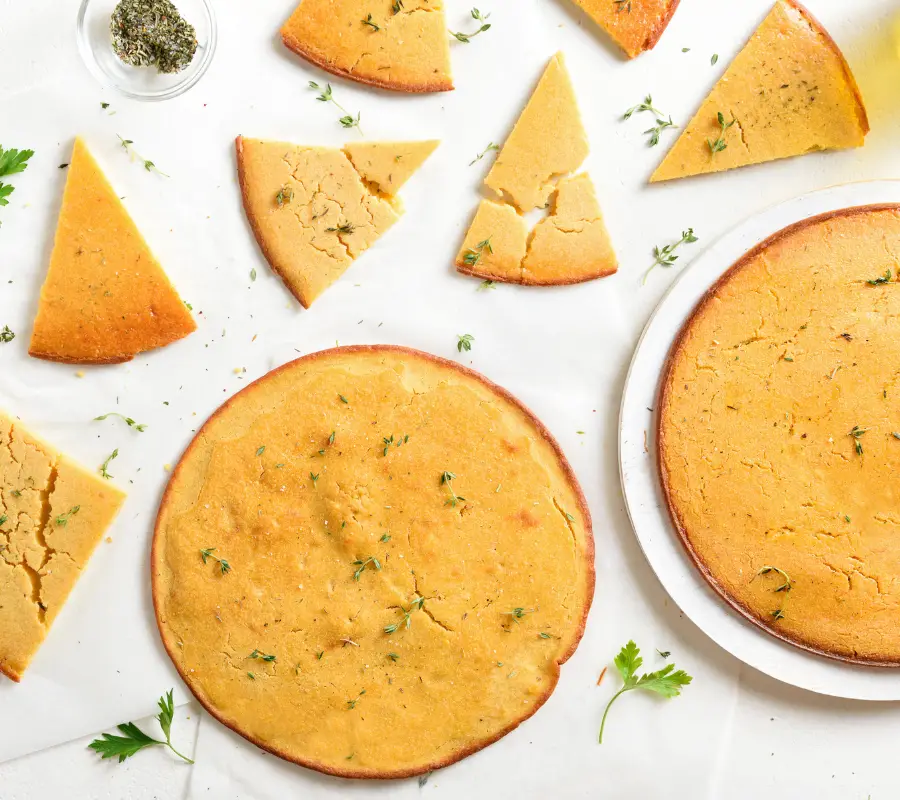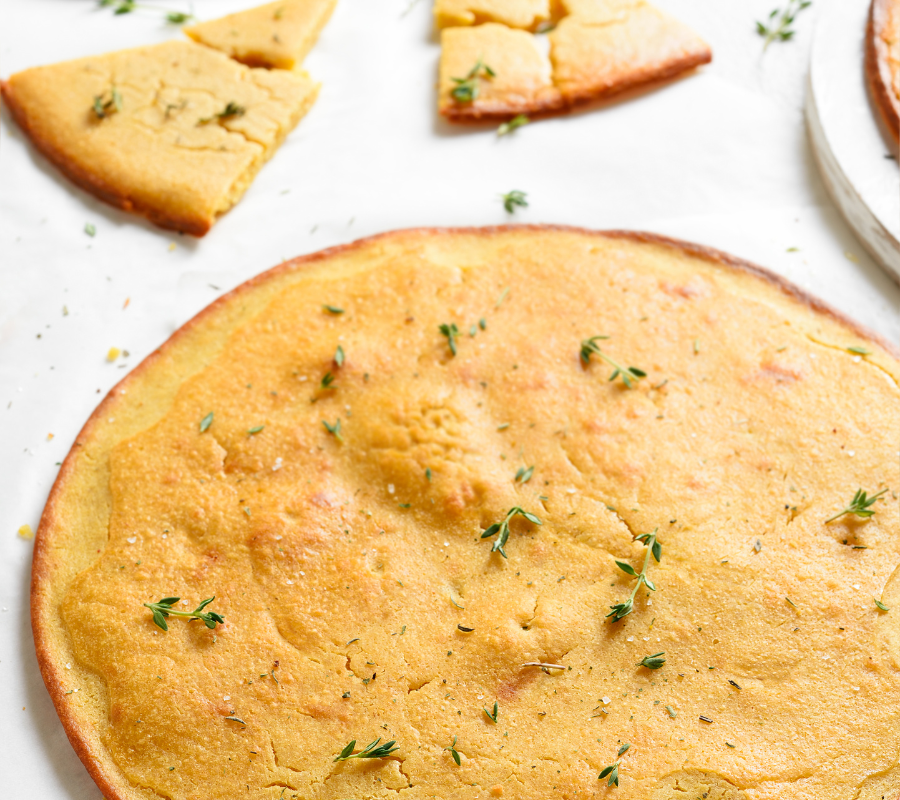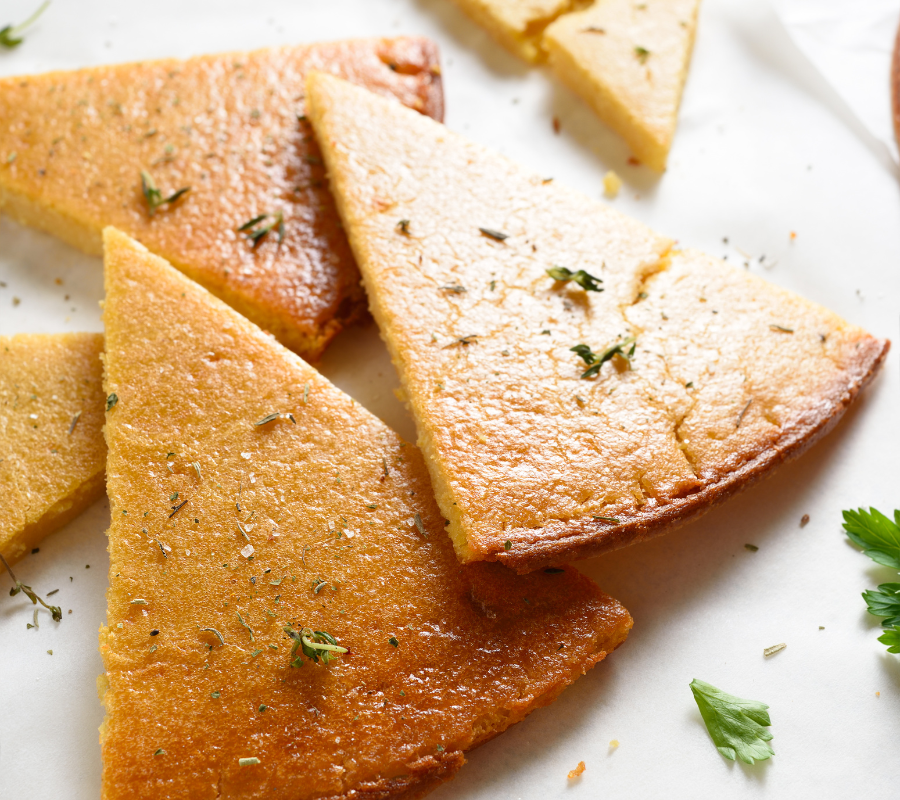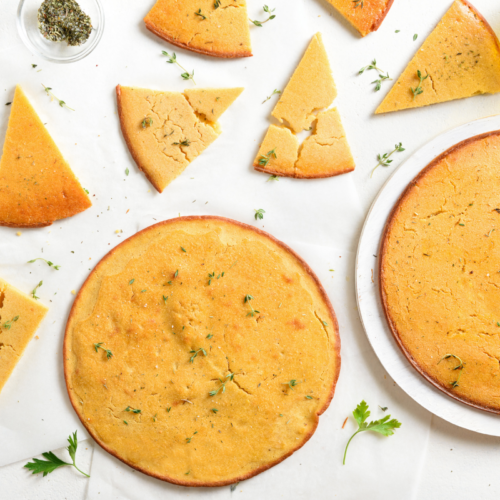Easy Gluten-Free Flatbread Recipe – 3 Ingredients!
Simple steps for gluten-free flatbread with chickpea flour. Also known as socca. So easy and tasty!

Essential Ingredients and Substitutions
Making socca requires a few key ingredients, but there are options for substitutions to cater to different dietary needs or preferences. Ensuring the ingredients are at room temperature can aid in creating a smooth batter.
Chickpea Flour Variants
Socca’s main ingredient is chickpea flour, also known as gram flour, which is a staple in gluten-free baking. This flour brings a nutty taste and is integral to achieving the authentic texture of the flatbread. For those exploring alternative gluten-free options, almond flour or coconut flour can be used, though they will alter the flavour and consistency. Another variant could be buckwheat flour; while not traditional, it can serve as a substitute for chickpea flour.
- Rice flour or tapioca starch can provide binding qualities in absence of gluten and are often found in new recipes, particularly gluten-free blends.
Oil Selection
Olive oil is traditionally used in socca for its rich flavour and health benefits. To keep the dish gluten-free and to add a subtle sweetness, coconut oil can be a suitable alternative. If you’re aiming for a socca with less saturated fat, vegetable oil can be used, though it might lack the characterising taste that extra virgin olive oil imparts.
- Oils should be added to the batter and also used to grease the non-stick pan to ensure that the socca cooks to a golden brown without sticking.
Seasonings and Spices
Simple ingredients like sea salt and pepper are essential for enhancing the natural flavours of the chickpea flour. For added depth, a mix of herbs such as rosemary or thyme can be included. Garlic powder is often favoured for an extra kick, fitting for an easy flatbread recipe that pairs well with dips or as a sandwich wrap.
- Incorporate spices and seasonings directly into the batter to distribute the flavours evenly. Aromatic options like garlic powder or freshly chopped herbs can elevate the flatbread to the best part of any meal.
Ingredients For Gluten-Free Flatbread
- 1 Cup Chick pea flour
- 1 Cup Water
- 1½ tbsp Olive Oil
Optional Extras
- Salt
- Za’atar (or any herbs you fancy)
How to make flatbread that are gluten-free
STEP 1: Whisk the chickpea flour, water, olive oil, and salt if using together in a medium bowl until smooth. Let it rest for 30 minutes to give the flour time to absorb the water.
STEP 2; Arrange an grill rack 6 inches below the broiler element and heat on medium to high or if using the oven 230℃/450°F. About 5 minutes before the batter is done resting, place a 10-inch cast iron pan/skillet in the grill to heat up.
STEP 3: Remove the hot pan/skillet from the oven. Add about 1 teaspoon of oil, enough to coat the bottom of the pan when the pan is swirled. Pour the batter into the centre of the pan. Tilt the pan so the batter coats the entire surface of the pan.
STEP 4: Cook until you see the top of the socca begin to blister and brown, 5 to 8 minutes. The socca should be fairly flexible in the middle but crispy on the edges. If the top is browning too quickly before the batter is fully set, move the skillet to a lower oven rack until done or reduce the heat.
STEP 5: Use a flat spatula to work your way under the flatbread and ease it from the pan onto a cutting board. Slice it into wedges, sprinkle with salt and pepper, and drizzle with more olive oil and sprinkle with the za’atar or herbs if using.

Cooking Tools and Equipment
To prepare socca successfully, it’s crucial to use the appropriate cooking tools and equipment that can withstand high temperatures and distribute heat evenly.
Best Type of Skillet
A cast iron skillet is the most recommended surface for making socca. The skillet’s heavy base ensures even heat distribution, allowing the flatbread to cook thoroughly and acquire a desirable golden brown crust. Preheat the cast iron pan in the oven or under the grill/broiler to achieve the best results, ensuring the batter starts cooking the moment it hits the pan.
Alternative Cooking Surfaces
If a cast iron skillet is not available, a non-stick pan or griddle can be used on the stovetop at medium-high heat.
Though less traditional, these alternatives can still yield a tasty gluten-free bread when coated with a little olive oil to prevent sticking. For those using a blender or whisk to mix the batter, make sure it is smooth and at room temperature for consistency and ease of spreading on the chosen cooking surface.
Preparing the Perfect Socca Batter
Achieving the right consistency and employing the proper mixing technique are crucial for making a successful socca, a delectable gluten-free flatbread made predominantly with chickpea flour.
Mixing Technique
Begin by placing the chickpea flour into a large bowl. For a touch of flavour, a dash of sea salt and a generous drizzle of olive oil should be added. Now, gently pour room temperature water over the dry ingredients.
Using a whisk, combine the ingredients with a steady hand to avoid lumps. The main ingredients should blend to create a smooth mixture. For those with gluten-free baking needs, this process ensures that the batter remains gluten-free, avoiding cross-contamination that could affect individuals with celiac disease.
Batter Consistency
The key to socca’s delightful texture lies in the batter consistency being neither too thick nor too moist. It should be somewhat reminiscent of heavy cream. If the batter appears too thick, adding a little water can help achieve the desired consistency without resorting to gluten-containing flours.
Chickpea flour, being naturally gluten-free and high in protein, makes an excellent base for this recipe, but alternatives like almond flour or coconut flour might be used for different nutritional content or flavour profiles.
Remember, the batter should be a bit little sticky before cooking to ensure it holds together well in the hot pan, turning golden brown upon cooking to create that signature gluten-free bread experience.
Cooking Process
Making socca involves a simple yet precise approach, focusing on correct oven temperatures and utensil choices for the optimal gluten-free flatbread experience.
Oven-Baked Socca
Begin by preheating your oven to a high temperature, typically around 230°C (450°F). While the batter – a blend of chickpea flour, water, and olive oil – rests at room temperature, place a cast iron skillet within the oven to heat up as well.
This process ensures that the batter starts cooking immediately upon contact, leading to a well-formed flatbread. For those exploring gluten-free baking for the first time, chickpea flour is the main ingredient, but alternatives such as almond flour or coconut flour can also be experimented with in new recipes.
Stovetop Method
For a stovetop socca, warm a non-stick pan or a well-seasoned cast iron skillet over medium heat. Once hot, drizzle some olive oil and pour the batter, spreading it evenly. The batter should be a little sticky but will set as it cooks. Regular flatbread might require a rolling pin, but this easy flatbread recipe only needs a wooden spoon to spread the batter. Cook until the bottom side of the socca is golden brown, then flip carefully to cook the other side, achieving a gluten-free version akin to traditional pita bread.
Grill/Broil for a Crisp Finish
After baking or cooking on the stovetop, if a crispier finish is desired, the socca can be placed under a grill/broiler set to high for a few minutes. Keep a vigilant watch to ensure it doesn’t burn.
This final step will give your socca the best part of its texture, reminiscent of a crispy pizza crust, which is popular on social media for its versatility as a sandwich wrap or accompaniment to your favourite soup. Using a grill/broiler provides a golden brown colour and a delightful, crunchy surface, enhancing the simplicity and appeal of this gluten-free delight.

Flavour Enhancements and Variations
To elevate the simple socca into a gastronomic delight, integrating key flavour enhancements and experimenting with various toppings will enrich its taste and versatility. Utilising simple ingredients such as fresh herbs and aromatic-infused olive oil can profoundly impact its profile, and the addition of diverse toppings turns it into a canvas for creativity akin to a gluten-free pizza crust.
Herbs and Aromatics
Infusing the chickpea batter with herbs and aromatics is a straightforward technique to impart depth of flavour to socca. Classic Provencal herbs such as rosemary, thyme, and oregano can be mixed directly into the batter. Fresh garlic or garlic powder adds a piquant edge, while a pinch of cumin offers an earthy warmth. A final squeeze of lemon juice can further enhance the socca with a fresh zesty note.
- Fresh herbs: chopped finely and stirred in
- Aromatic olive oil: drizzled over or into the batter
- Seasoning: sea salt and freshly ground black pepper to taste
- Additional spices: cumin, turmeric, or smoked paprika for complexity
Creative Toppings
After mastering the basic socca recipe, adventurous culinary artists can use it as a foundation for creative toppings, transforming the flatbread into a robust dish. From a sprinkle of grated cheese that will turn golden brown under the grill to a spread of ripe tomato slices finished with a drizzle of olive oil, the possibilities echo those of a traditional pizza crust. Incorporating olives, sautéed mushrooms, or artichokes can elevate the dish, offering a satisfying alternative to regular flatbread for those on a gluten-free diet or with celiac disease.
- Savoury toppings: sliced olives, caramelised onions, sautéed greens
- Cheese options: feta, goat cheese, or vegan cheeses for those avoiding saturated fat
- Final touches: a sprinkle of herbs or a dollop of tzatziki sauce before serving
Experimenting with socca allows for a beautiful blend of new recipes and traditions, creating a gluten-free bread that’s delicious on its own or as part of a more substantial meal. Whether you’re looking for an easy flatbread recipe to serve with your favourite soup or a robust base for your favourite pizza toppings, socca is versatile enough to accommodate. Keep it stored in an airtight container to maintain freshness and always aim for best results by allowing the batter to rest at room temperature before cooking on a hot pan.
Serving and Pairing Suggestions
Socca, a delightful chickpea flour-based flatbread, offers a versatile platform for a variety of dishes. It shines with its simplicity and the earthy flavours of its main ingredients. Below are some ways to serve socca, be it as a snack or as part of a larger meal.
As a Standalone Snack
Socca can be enjoyed warm and fresh, cut into triangles. For an extra touch of flavour, brush with olive oil and sprinkle with sea salt just after baking until golden brown. This simple preparation highlights socca’s naturally nutty taste and pleasing texture.
Accompaniments and Dips
When served as an appetizer, socca pairs excellently with an array of dips and spreads. Traditional choices like vegan pesto or hummus complement socca’s distinct profile. To embrace gluten-free baking, alternatives such as almond flour or coconut flour can be used in these dips for the best results. For dips with a creamy consistency, full-fat coconut milk enhances the richness without overpowering the socca.
Innovative Main Dishes
Socca’s sturdy texture makes it an ideal pizza base for those adhering to a gluten-free diet. To craft a pizza, simply top the socca with your favourite toppings, such as veggies and vegan cheese like parmesan. Alternatively, use socca as a sandwich wrap or as an accompaniment to green salads and soups. To maintain socca’s integrity, store leftovers in an airtight container and reheat on medium heat for a revived experience.
Storing and Reheating
Proper storage and reheating methods are crucial to maintain the quality of freshly-made socca. This gluten-free flatbread should be kept at room temperature or chilled to preserve freshness, depending on when it will be consumed.
Keeping Socca Fresh
To keep socca fresh after it has been cooked, it should be allowed to cool to room temperature. Once cool, place the socca in an airtight container, separating each piece with parchment paper to prevent sticking. Store the flatbread in the refrigerator for 3-4 days for the best part of its shelf life. If you prefer to keep the socca at room temperature, ensure it’s consumed within a day to maintain its best quality. Olive oil brushed on the surface can help keep it from drying out.
Freezing and Thawing
Socca can be frozen for long-term storage. Wrap the flatbread pieces individually in plastic wrap and then place them in a large, airtight container or a freezer bag. Frozen socca will keep for up to two months. When you’re ready to enjoy your socca again, thaw it overnight in the refrigerator or at room temperature for a few hours.
To reheat, place the socca in a non-stick pan over medium heat until it is warm and regains a golden brown crispiness. Alternatively, toast it in a toaster oven or under a grill briefly. This method helps the flatbread retain the desired texture and warms it evenly, ensuring the flatbread is just as satisfying as when it was freshly made.
Recipe Notes and Common Mistakes
When attempting a new recipe, especially one that requires a specific dietary consideration like gluten-free baking, attention to detail is crucial. Below are tips and adjustments to ensure your socca is a success on the first time.
Batter Tips
Main Ingredients: The batter for socca primarily consists of chickpea flour, water, and olive oil. Chickpea flour, also known as gram or besan flour, creates a naturally gluten-free bread, perfect for those adhering to a gluten-free diet or with celiac disease.
- Room Temperature: For best results, ensure that all your wet ingredients are at room temperature before mixing. This helps in creating a batter that is even and smooth.
- Consistency: The batter should be a little sticky but pourable, similar to pancake batter. If too thick, add a little water until the desired consistency is achieved.
- Resting the Batter: Letting the batter rest allows the chickpea flour to fully hydrate, resulting in a creamy interior upon cooking. Aim for at least 30 minutes of rest time.
- Mixing: Use a large bowl and a wooden spoon or a whisk to thoroughly combine the ingredients, eliminating any lumps for an even, homogenous mix.
- Alternative Flours: If you wish to experiment, gluten-free flours like rice flour or buckwheat flour can be used alongside chickpea flour. Additions like tapioca starch or potato starch can aid in binding and texture.
Cooking Adjustments
Cookware: A cast iron pan is essential for achieving the characteristic golden brown and crisp edges of the socca. Ensure it’s very hot before pouring in the batter.
- Heat: Cook the socca over medium-high heat if using a stovetop method. For oven cooking, a high temperature of around 230°C (450°F) and preheating the pan under the grill/broiler are key steps.
- Olive Oil: Use a generous amount of olive oil to coat the pan to prevent sticking and to add flavour. For a variation, coconut oil can be used.
- Cooking Time: Watch the socca closely. It typically cooks quickly and can take about 2-3 minutes on the first side. It should be firm and golden brown before flipping or removing it from the heat.
- Storing: Cooked flatbreads can be stored in an airtight container. They are best enjoyed the same day but can be refreshed in a toaster oven or non-stick frying pan if needed.
By carefully mixing the batter and making the necessary cooking adjustments, socca can become a favourite gluten-free bread option that’s easy to customise and enjoy in different ways, such as a pizza crust or sandwich wrap. It’s a simple flatbread recipe that doesn’t require special equipment or complicated steps, making it approachable for any home cook.
Frequently Asked Questions
Socca flatbread, with its rich flavour and nutrient profile, often leads to inquiries about its preparation and ingredients. These frequently asked questions cover its traditional make-up, cooking techniques, and dietary suitability.
What ingredients are needed to make a traditional socca flatbread?
Traditional socca flatbread requires simple ingredients: chickpea flour as the main ingredient, water to create the batter, olive oil for richness and to prevent sticking, and sea salt for seasoning.
How do you cook socca on a stovetop to achieve the perfect texture?
To cook socca on a stovetop, heat a non-stick pan or preferably a cast iron skillet over medium-high heat. The batter should be poured into the hot pan and cooked until the underside is golden brown and the edges start to crisp up, resulting in a perfect texture.
What are the steps to creating the best authentic French socca?
For the best authentic French socca, start by whisking together chickpea flour, water, olive oil, and salt in a large bowl until smooth. Let the batter rest at room temperature, then pour it into a preheated pan and bake until it is firm and golden brown. The key is allowing the batter to rest and using a hot pan to achieve that signature socca crispness.
Can almond flour be effectively used as a substitute for chickpea flour in socca recipes?
While almond flour can be used in gluten-free baking, it is not a direct substitute for chickpea flour due to differences in taste and texture. Socca’s unique flavour and structure are best achieved with chickpea flour, although almond flour might be used in other gluten-free flatbread recipes.
Is socca considered a gluten-free option for those with dietary restrictions?
Yes, socca is a naturally gluten-free bread option suitable for individuals on a gluten-free diet, including those with celiac disease. It’s made from chickpea flour, which is free from gluten, unlike regular flatbread made with purpose flour.
Which type of pan yields the best results when cooking socca?
The best results when cooking socca are typically achieved with a cast iron skillet due to its excellent heat retention and distribution properties. It helps in creating a consistently cooked flatbread with a pleasingly crispy exterior.

Easy Gluten-Free Flatbread Recipe – 3 ingredients!
Equipment
Ingredients
- 1 Cup Chick pea flour
- 1 Cup Water
- 1½ tbsp Olive Oil
Optional Extras
- Salt
- Za'atar (or any herbs you fancy)
Instructions
- Whisk the chickpea flour, water, olive oil, and salt if using together in a medium bowl until smooth. Let it rest for 30 minutes to give the flour time to absorb the water.
- Arrange an grill rack 6 inches below the broiler element and heat on medium to high or if using the oven 230℃/450°F. About 5 minutes before the batter is done resting, place a 10-inch cast iron pan/skillet in the grill to heat up.
- Remove the hot pan/skillet from the oven. Add about 1 teaspoon of oil, enough to coat the bottom of the pan when the pan is swirled. Pour the batter into the centre of the pan. Tilt the pan so the batter coats the entire surface of the pan.
- Cook until you see the top of the socca begin to blister and brown, 5 to 8 minutes. The socca should be fairly flexible in the middle but crispy on the edges. If the top is browning too quickly before the batter is fully set, move the skillet to a lower oven rack until done or reduce the heat.
- Use a flat spatula to work your way under the flatbread and ease it from the pan onto a cutting board. Slice it into wedges, sprinkle with salt and pepper, and drizzle with more olive oil and sprinkle with the za'atar or herbs if using.